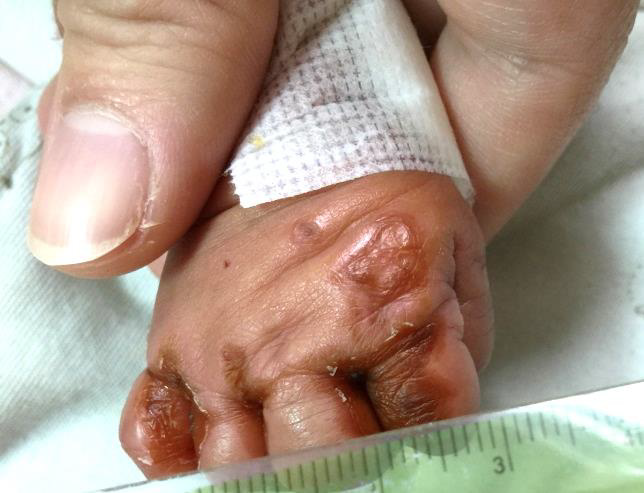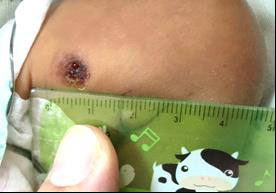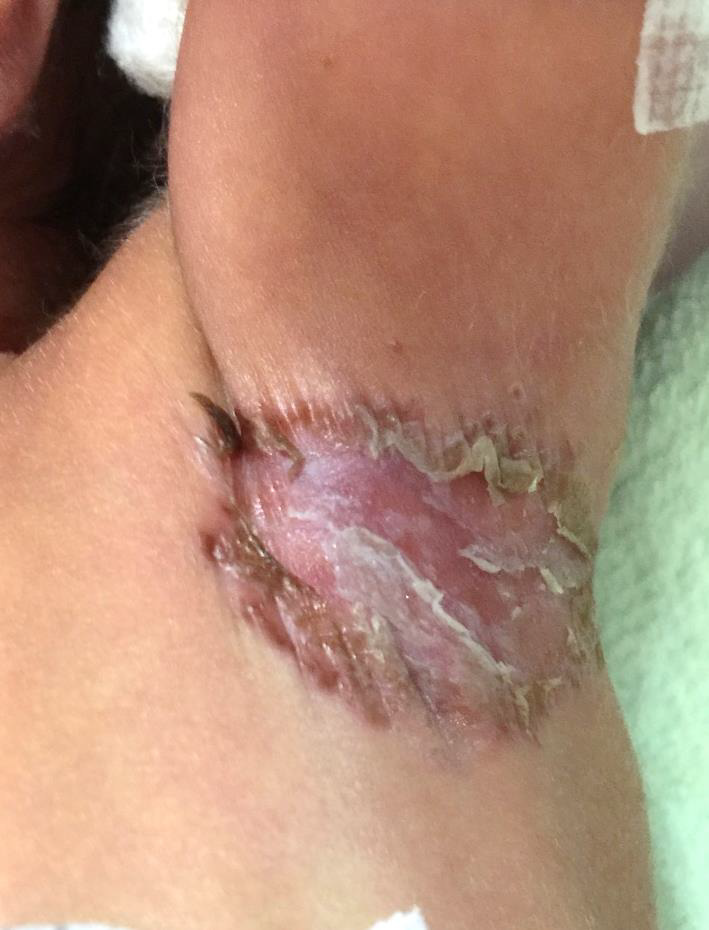ABSTRACT
Objective: Zinc deficiency and its evaluation is recommended in the newborn with dermatologic manifestation that cannot be explained otherwise.
Design: We present a case of preterm infant with necrotizing enterocolitis who developed transient zinc deficiency dermatitis.
Results: The zinc deficiency skin lesions totally recovered after one week of zinc supplementation
Conclusion: Early recognition of zinc deficiency dermatitis and zinc supplementation rapidly reverses transient zinc deficiency dermatitis totally.
Introduction
Zinc plays a vital role in growth and development, cell proliferation, tissue repair, and cellular immunity. Zinc is considered very essential for oligodendrogenesis, neurogenesis, neuronal differentiation, white matter growth, and multiple physiological and biological roles in neurobiology [1]. Preterm infant is said to have high zinc dietary requirements because 60% fetal zinc is acquired during the third trimester of pregnancy which is not stored because of early delivery [2]. Therefore, premature infants are especially susceptible to zinc deficiency. It is the aim of this report to point out that a clinical suspicion of Zinc deficiency is warranted in any preterm who present with dermatologic manifestation that cannot be explained otherwise.
Case
A very low birth weight preterm delivered at 29 weeks of gestation with a birth weight of 1,180 grams born w/ dyspnea, intubated for congenital pneumonia treated with parenteral antibiotic. Moderate patent ductus arteriosus was closed with 3 doses of parenteral ibuprofen. Grade II B necrotizing enterocolitis (NEC) was diagnosed at 26th day of life which required treatment with parenteral antibiotics & prolonged total parenteral nutrition. She then presented with a 2 weeks of progressively extensive, erosive, eczematous crusted eschar looking like blistering skin lesions over the perioral region, right side of neck, hands, left axillary fossa, left thigh, and gluteal region (Figures 1-3). Laboratory investigations revealed WBC: 10,430/μl , CRP:1.73 mg/dl. Gentamycin cream was added for topical skin lesion use. IV antibiotics with Cefazolin and Gentamicin were given for suspected bacterial infection-associated skin lesions. Gram stains & cultures from skin lesions and blood were negative. For the condition of prolonged parenteral nutrition used, a clinical diagnosis of zinc deficiency was considered. The infant’s serum zinc level was decreased (511 mcg/L; normal range: 700-1200 mcg/L). Zinc deficiency was confirmed by the finding of low plasma zinc concentration. Parenteral zinc supplementation at a dose of 500 mcg/kg/day was started again after almost 1.5 months of shortage in supply of parenteral zinc in the country. After treatment with zinc supplementation, skin lesions dramatically improved within two-three days of treatment and recovered after one week of treatment. Complete resolution of the skin lesions is seen with no scar formation after zinc deficiency treatment.
Discussion
Severe zinc deficiency causes dermatitis, alopecia, diarrhea, neurologic symptoms such as irritability and altered behavior, and limitation of growth [3]. Zinc deficiency in breastfed mainly preterm infants is a condition with similar clinical findings as in acrodermatitis enteropathica, an autosomal recessive disorder of enteric zinc absorption [4]. Skin lesions are classically located in periorificial, intertriginous, and acral areas. Skin lesions usually appear as early small moist and erythema, progressing to eschar lesions [5]. These lesions may be the seat of numerous bacterial superinfections because of the impaired immune function induced by zinc deficiency. Premature infants are especially susceptible to a negative zinc balance, even under the conditions of adequate intake. Their zinc deficiency symptoms are associated with rapid growth and increased zinc requirements, with the immaturity of their digestive system combined with increased intestinal zinc elimination and decreased absorption, and with small zinc reserves in their muscles and bones [6].
However, premature and low-birthweight infants may also develop symptoms even when receiving milk with normal zinc levels. Infants with NEC were treated with long-term total parenteral nutrition, leading to the increased trace element lost from the inflamed gut mucosa and incapable intestinal absorption of zinc which make them especially susceptible to the development of zinc deficiency. The zinc deficiency in our case was caused by the transient shortage of supply of parenteral zinc in our country when she can not take oral zinc supplement because of her NEC. Administration of zinc preparation at a daily oral dosage of 1-2 mg/ kg/day is the treatment of choice in infants with zinc deficiency [7]. Rapid improvement in skin lesions is noted within days, and clearance occurs within 4–28 days [8]. Remission of other symptoms occurs within weeks to months. The differential diagnoses include chronic mucocutaneous candidiasis, atopic dermatitis, contact dermatitis, impetigo, and metabolic disorders such as biotin and other decarboxylase deficiencies, organic acidurias, and essential fatty disorders [9].
Conclusion
Premature infants have a negative zinc balance mainly secondary to inadequate stores because of their early delivery, and high requirements are at risk of developing zinc deficiency. Early recognition of the disorder and introduction of zinc supplementation rapidly reverses transient zinc deficiency. Thus, it is essential for a prompt diagnosis and effective treatment of zinc deficiency especially in premature to prevent a severe zinc deficiency resulting in neurologic sequelae and growth failure.
Conflict of Interest
No conflict of interest with any institution/organization.
References
- Brion LP, Heyne R, Lair CS (2021) Role of zinc in neonatal growth and brain growth: review and scoping review. Pediatr Res 89(7): 1627-1640.
- Islam MN, Chowdhury AK, Siddika M, Hossan MA, Hossain MK (2009) Effect of zinc on growth of preterm babies. Mymensingh Med J 18(1): 125-130.
- Hiroyuki YANAGISAWA (2004) Zinc deficiency and clinical practice. JMAJ 47(8): 359-364.
- Jensen SL, Mccuaig CC, Zembowicz A, Hurt MA (2008) Bullous lesions in acrodermatitis enteropathica delaying diagnosis of zinc deficiency: a report of two cases and review of the literature. J Cutan Pathol 35(1): 1-13.
- Obladen M, Loui A, Kampmann W, Renz H (1998) Zinc dificiency in rapidly growing preterm infants. Acta Paediatr 87(6): 685-691.
- Ursula KK, Fink FM, Elisabeth SG (2007) Transient Symptomatic Zinc Deficiency in a Breast-fed Preterm Infant. Pediatr Dermatol 24(5): 536-540.
- Hiroko KODAMA (2004) Trace Element Deficiency in Infants and Children Clinical Practice. JMAJ 47(8): 376-381.
- Zattra E, Fortina AB (2013) Transient symptomatic zinc deficiency resembling acrodermatitis enteropathica in a breast-fed premature infant: case report and brief review of the literature. G Ital Dermatol Venereol 148(6): 699-702.
- Stevens J, Lubitz L (1998) Symptomatic zinc deficiency in breast-fed term and premature infants. J Paediatr Child Health 34(1): 97-100.

 Case Report
Case Report


